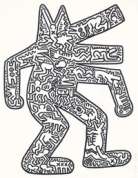
Dog

Dog
Signed Print
Keith Haring
£70,000-£100,000
$140,000-$200,000 Value Indicator
$130,000-$180,000 Value Indicator
¥660,000-¥940,000 Value Indicator
€80,000-€110,000 Value Indicator
$730,000-$1,040,000 Value Indicator
¥14,530,000-¥20,760,000 Value Indicator
$90,000-$130,000 Value Indicator
There aren't enough data points on this work for a comprehensive result. Please speak to a specialist by making an enquiry.
116 x 90cm, Edition of 40, Lithograph
Auction Results

Track auction value trend
Meaning & Analysis
This signed lithograph on Rives paper from 1985 is a limited edition of 40 from Keith Haring’s Dog series. The print Dog shows an image of a human-like dog standing upright, with stick figures, televisions, dogs and other unidentifiable creatures populating the inside of the dog’s body. Haring produces this print in his distinct and simplified linear style using black, bold lines against a plain white background.
The barking dog has become an iconic symbol created by Haring, first appearing in his Subway Drawings series from 1980-1985. Emerging as a symbol to represent authoritarian government, abuse of power and oppressive regimes, this print speaks to the way in which Haring warns the viewer of those in power throughout much of his oeuvre. Haring repurposes the playful motif of the dog, a symbol used throughout art history to represent loyalty, companionship and obedience, to remind viewers to question their assumptions at first glance.
Haring creates a pattern of menacing creatures to decorate the standing dog figure as a nod to the often overlooked oppression in society. At first glance, the figure seems to be decorated with Aztec or Aboriginal inspired designs, but upon closer inspection the chaos of the scene emerges. Haring provides the viewer with a glimpse of Hell in this image, showing human-like figures devouring, having sex with and clambering on top of one another and with a devil-like figure spreading its wings at the top of the image.